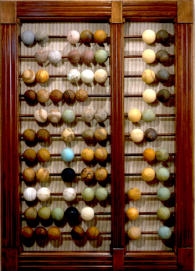

MAKING A SAINT
(ST. THERESA OF AVILA) I & II,
Commissioned for the exhibition: Remembering the present, The Kreeger Museum, Washington, D.C. Spring 2000. In consideration of the relevance of monuments, I am struck at once by the fact that whatever their designations, monuments are not for everyone. In this country the statue of a Civil War era Union general might be toppled if he had actually been perched in the South, upon the ground he mortally consecrated. Monuments are not construed as paradigms by an enemy. Receiving equal import are religious statues. Aside from deities, most statues (monuments) are of saints who were in fact scoffed or worse in their lifetime. It’s not easy being a saint.
Saint Theresa of Avila died in 1582 and was
subsequently canonised by the Vatican in 1622.
During her life she had every intention of becoming
a saint. As a mystic, she was subjected to
prolonged illnesses and passions that, by virtue of
their duration, became quite public and aroused
suspicions, dangerous for a woman during the
Spanish Inquisition.
Equally provocative, Theresa was an aggressive
public advocate and administrator of several
monastic communities that existed by virtue of her
guile.
Befitting her stature, and as a qualification of her
imprimatur to sainthood, her body has been
exhumed five times for the purpose of
examination, the excision of one body part or
other going off to individuals and reliquaries
(Franco kept her hand by his bed), and subsequent
relocation of the remains to locations that claimed
her as a prize.
MAKING A SAINT
(ST. THERESA OF AVILA) I & II,
2000
found wood, polyethylene, rubber, cork
72” x 51” x 6”
Private collection


